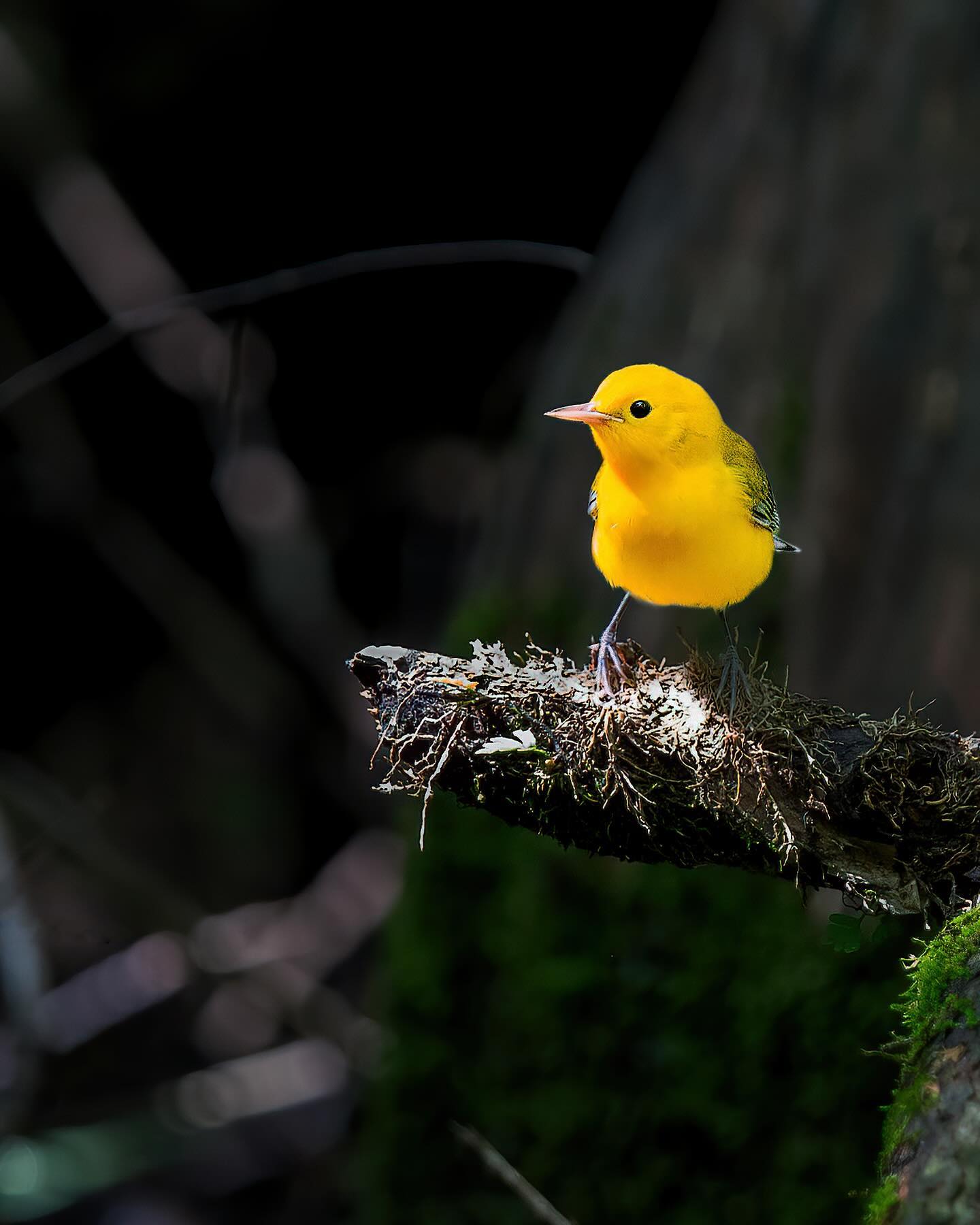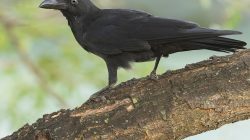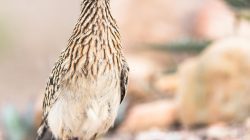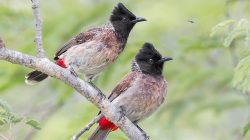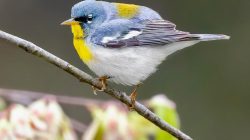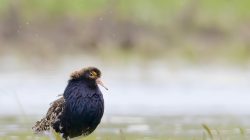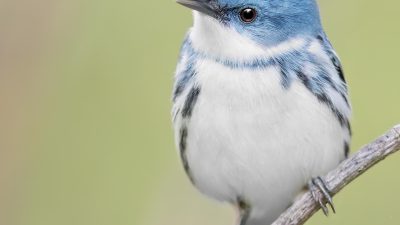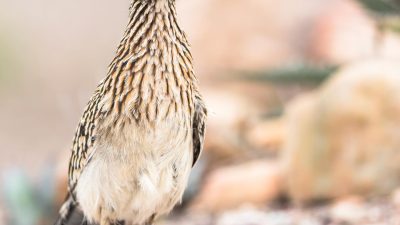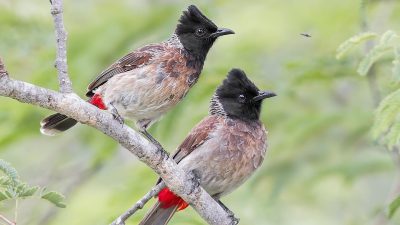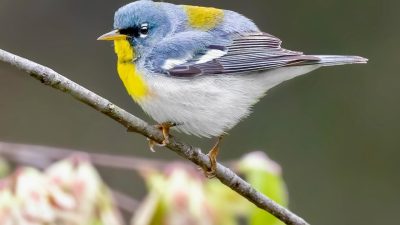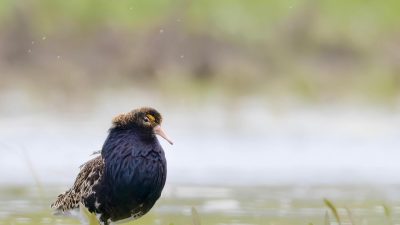Prothonotary Warbler (Protonotaria citrea)
Diajar.net –The Prothonotary Warbler, scientifically named Protonotaria citrea, derives its common name from the Latin word protonotarius, which refers to a high-ranking clerk in the papal court. This naming tradition stems from the bird’s vibrant yellow color, resembling the ceremonial attire of those clerks. The species epithet citrea is derived from the Latin word for “citron” or “lemon,” alluding to the bird’s striking yellow plumage. This species is often associated with the American Warblers, a group of small, migratory songbirds in the family Parulidae, known for their distinct coloration and melodious songs.
The Prothonotary Warbler was first described in 1810 by the American ornithologist Alexander Wilson, one of the first to document the avifauna of the United States. Wilson was deeply fascinated by the diversity and vibrancy of bird species found in North America, and he played a pivotal role in the identification of many species. The bird’s name, both its genus and species, reflects its vibrant, almost royal appearance.
Appearance
The Prothonotary Warbler is a small, brightly colored songbird that exhibits a remarkable appearance, making it one of the more striking warblers in North America. Adult males, in particular, are known for their vivid yellow plumage on their underside, which is often likened to the color of fresh lemons. Their bright yellow feathers contrast sharply with a darker, olive-greenish back, giving them an almost two-tone appearance.
A closer look at their physical features reveals a sharp, pointed beak that is well-suited for insectivorous feeding habits. The Prothonotary Warbler also has an eye-catching blackish-blue crown, which provides a beautiful contrast to its bright yellow body. These birds have a relatively small body size, typically measuring about 12 to 13 centimeters in length, with a wingspan of approximately 20 centimeters. Their tail is slightly rounded, and their legs and feet are generally a grayish color.
The females, while similar in appearance to males, may display slightly duller colors. Juvenile Prothonotary Warblers, upon fledging, are mostly olive-gray with yellowish undertones, gradually developing the bright yellow plumage of the adult over time.
This bird’s vibrant yellow appearance makes it easily identifiable in its natural habitat, and it is often observed flitting energetically among trees and shrubs, searching for insects.
Distribution
The Prothonotary Warbler is primarily found in eastern North America, with a range that extends from southern Canada down to parts of Central America. These migratory birds are commonly found in the United States, especially in areas such as the southeastern states, including parts of Florida, Alabama, and Mississippi. During migration, the Prothonotary Warbler will travel between its breeding grounds in the eastern United States and its wintering grounds in Central America, notably in Panama and parts of northern South America.
Their distribution is largely dependent on the availability of suitable habitats. Prothonotary Warblers are often found in wetlands, swamp forests, and along riverbanks, where the conditions provide ample nesting sites and abundant food resources. They are particularly associated with habitats that have an abundance of dead or decaying wood, such as flooded forests and riparian zones, which is vital for their nesting and feeding behaviors.
Though their range is expansive, Prothonotary Warblers are not commonly found in urban areas, preferring the serenity and natural environments of woodlands and wetland ecosystems. In fact, they tend to avoid areas that have been heavily altered by human activity, including cleared or cultivated land, which diminishes their ability to thrive.
Geography
Geographically, the Prothonotary Warbler’s habitat is centered around the eastern and southern parts of the United States. They breed in a range of states, with high concentrations in Kentucky, Tennessee, North Carolina, and other areas with extensive riparian forests. These birds tend to avoid mountainous terrain, instead favoring lowland and floodplain areas, where they can take advantage of the swampy conditions for breeding.
During migration, these birds travel a considerable distance southward, as their preferred wintering locations are in Central America, including the coasts of Panama, Honduras, and Nicaragua. Their wintering grounds are typically characterized by humid tropical forests and riverine ecosystems.
The geographic location of the Prothonotary Warbler also determines the seasonal patterns of its migration. As they are migratory birds, they leave their breeding grounds during the colder months, usually beginning their migration in late autumn, and return in early spring. This seasonal movement is guided not only by temperature but also by the availability of food resources along their migratory route.
Habits and Lifestyle
The Prothonotary Warbler is a non-aggressive and relatively solitary bird outside of the breeding season, although it may form small, loose groups during migration. It is known for its energetic and acrobatic behavior as it searches for food. Unlike many other warblers, which are primarily insectivores, the Prothonotary Warbler is also known to forage for small fruits, berries, and seeds, especially during migration and in wintering areas when insects are less abundant.
These warblers are highly territorial during the breeding season, with males establishing and defending territories that they vigorously guard against rival males. Their nests are typically built in tree cavities or other hollows in trees near water, where they lay between 4 and 6 eggs. The males will often attract females by singing a series of melodic, warbling calls from high perches within their territories.
The lifestyle of the Prothonotary Warbler is closely tied to the seasonal changes in their habitat. During the breeding season, they are most active in the early morning and late afternoon, taking advantage of the quieter hours of the day for feeding and territorial displays. Their songs, a series of sweet, clear notes, are used to communicate both with other warblers and to attract mates.
Outside of the breeding season, Prothonotary Warblers become less vocal, retreating to the more sheltered environments of the southern wetlands and tropical forests. Here, they continue to forage and rest, preparing for their return journey in the spring.
Diet and Nutrition
The Prothonotary Warbler is primarily an insectivore, feeding on a wide range of insects, including beetles, caterpillars, and various larvae, which it finds among the foliage and tree bark. They are particularly adept at catching insects by gleaning them from tree trunks or by snatching them from the air while hovering. During the breeding season, when the demand for energy is high, they feed almost exclusively on insects, which provide them with the necessary protein to sustain their high activity levels.
In addition to insects, the Prothonotary Warbler occasionally consumes small fruits and seeds, particularly when migrating or when insect populations are low. This adaptation allows the bird to survive in different environments and seasons, providing flexibility in its diet. The birds are also known to forage in moist, marshy habitats, where aquatic insects and small invertebrates are abundant.
The bird’s small size and active nature require a high metabolic rate, meaning that they must feed frequently throughout the day. Their foraging behavior is highly adaptive, allowing them to exploit a variety of food sources depending on their location and the time of year.
Population
The population of the Prothonotary Warbler has fluctuated significantly over the years, influenced by changes in habitat and climate. According to recent estimates, the global population of Prothonotary Warblers is around 2 million individuals. However, this number has seen some decline in recent decades due to habitat loss and changes in their breeding grounds.
The primary threats to the Prothonotary Warbler’s population are habitat destruction, particularly the draining of wetlands and riverbank areas, and the degradation of forests where they nest. Additionally, increased competition from invasive species and the effects of climate change, including altered migration patterns and food availability, have also contributed to a decrease in their numbers.
Despite these challenges, conservation efforts are being implemented to help stabilize the population of Prothonotary Warblers. In many regions, conservationists are focusing on protecting their natural habitats and restoring wetland ecosystems. These efforts are crucial in ensuring the continued survival of the species.
Number of Populations
The Prothonotary Warbler is generally considered a species with a relatively stable number of distinct populations, though these populations are distributed across different regions of the United States and parts of Central America. In the United States, there are a number of breeding populations found in the wetlands and riparian forests of the eastern and southeastern states. These populations are spread across several major ecological regions, including the Appalachian Mountains, the Gulf Coast, and the Mississippi River basin.
The populations in Central America are somewhat isolated, with breeding occurring in the lowland tropical forests near rivers and swamps. While these populations are fewer in number compared to those in North America, they are crucial for maintaining genetic diversity within the species.
The most significant population density of Prothonotary Warblers can be found in the southeastern United States, particularly in states like Alabama, Mississippi, and Louisiana. Smaller populations are scattered throughout the Midwest and even into parts of Canada, where the species breeds in suitable habitats along riverbanks and in wetland areas.
Conservation
The conservation status of the Prothonotary Warbler is currently classified as Least Concern by the International Union for Conservation of Nature (IUCN), although the species has faced significant challenges in recent years. Habitat loss remains the most significant threat to the Prothonotary Warbler, as wetlands and riparian forests are increasingly being drained for agriculture, urban development, and industrial use. The loss of these habitats directly impacts the bird’s breeding success, as it relies on tree cavities in moist, wooded environments.
In response to these threats, various conservation measures have been put into place. One successful strategy has been the installation of artificial nest boxes in suitable habitats, which mimic natural tree cavities. This has proven effective in increasing breeding success in areas where natural cavities are scarce. Additionally, several nonprofit organizations and government agencies are working to protect critical wetland habitats through legal protections and restoration efforts.
Another key element of Prothonotary Warbler conservation is monitoring and research. Ongoing studies of their migration patterns, breeding success, and population trends help inform conservation strategies and provide essential data for ensuring the species’ survival. Collaborative efforts between birdwatching communities, researchers, and environmental groups have been instrumental in raising awareness about the challenges facing this species.
As climate change continues to pose new challenges for migratory birds, including altered migration routes and changing seasonal conditions, ongoing conservation work will be critical to maintaining healthy populations of the Prothonotary Warbler. Protecting their habitat and supporting their migration will help ensure that future generations of these vibrant songbirds continue to grace the wetlands and forests of North America and Central America.
The Prothonotary Warbler remains one of the most charismatic and beautiful species in North America, and its conservation will depend on continued efforts to protect and restore its natural habitat.
